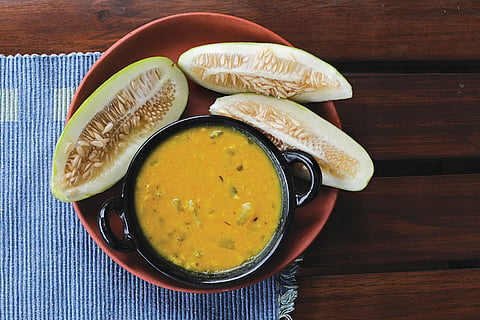

What do the Mangalore cucumber from Karnataka, the Madras cucumber from Tamil Nadu, the Malabar cucumber from Kerala, and the yellow cucumber from Andhra Pradesh and Telangana have in common? The answer, you may think, is fairly obvious—they are all just different varie-ties of cucumber found in the southern states. But their names belie an important fact—they are not different cucumbers at all, but rather a single type of melon, called culinary melon.
Unlike the sweet melon that we consume as a fruit, culinary melon or Cucumis melo variety acidulus is slightly sour and feels and tastes just like a gourd when cooked. The fruit is found in all southern states, where it differs not just by name but also by appearance, according to a 2022 book, Culinary Melons of South India. In Karnataka, the Mangalore cucumber or southekayi is ovate to oblate in shape, weighs up to 1.5 kg and has a green rind, sometimes patchy or striped. In Kerala (where it is also called vellarikka) and Tamil Nadu, the melon has yellow skin and weighs 1-1.5 kg. In Andhra Pradesh and Telangana, the fruit called dosakaya is small and globular, weighing just 0.5 kg, and has a yellow rind with patches.
In all the states, the fruit is largely used as a vegetable to prepare sambar or a stir-fried side dish. In Andhra Pradesh, it is also used with pigeon pea or tur to prepare a dal called dosakaya pappu and a spicy pickle called dosvakaya. In Kerala, the melon is used in vellarikka pachadi, which is similar to a raita (see recipes).
But even with such traditional recipes, culinary melon remains underutilised, say researchers. In the 2022 book, authors K R M Swamy, re-tired head of the Division of Vegetable Crops at the Indian Institute of Horticultural Research, Bengaluru, and Prem Nath, former assistant direc-tor general at the UN Food and Agriculture Organization’s regional office, compile research on the use, nutritive and medicinal value, origin, genetics and breeding of culinary melons.
The book cites research which suggests that the fruit is low in fat and cholesterol and has nutrients such as vitamin C and caffeic acid that are good for the skin. The hard skin is rich in fiber and minerals such as silica, magnesium and potassium that are good for the muscles, bones and connective tissues. About 100 g of fruit pulp has 3.63 g of carbohydrates, 1.67 g of sugars, 0.5 g of dietary fiber, 0.11 g of fat, 0.65 g of protein and significant levels of vitamins, iron, zinc, calcium and other nutrients.
Similarly, research suggests that the seeds contain 34.68 per cent oil on a dry weight basis, and primarily comprise nine fatty acids, with high concentrations of polyunsaturated fatty acids (80.54 per cent), linoleic acid (66.55 per cent), oleic acid (13.70 per cent), palmitic acid (11.65 per cent). Studies also show that the skin and flesh are rich in essential amino acids (threonine, arginine and glutamine), flavonoids, carboxylic acids and citrulline. The authors suggest that the centre of the fruit’s origin could be Africa. However, domestication may have occurred independently in south-eastern and eastern Asia, and India. Today, the primary centre of the fruit's diversity is in southwestern and central Asia.
The crop grows easily in rain-fed, irrigated areas and rice fallows during the kharif and summer seasons and is cultivated widely in southern India. It can be used throughout the year since it has a long shelf life of 65-300 days; in comparison, a musk melon lasts for just 15 days. The longevity can help ensure food security in regions that see periods of long and heavy rain, with hardly any fresh vegetables available. It can also be easily stored at room temperature for six months; in villages, it is common to see culinary melons hanging off kitchen roofs.
Swamy and Nath say the acidulus variety can be used to breed melons with longer shelf life. A hybrid of culinary and musk melons, for example, can last 45-90 days. Some improved, early-maturing varieties, Mudicode, Arunima and Saubhagya, have already been developed at Kerala Agricultural University and are grown in the state.
Ingredients
Tur: 1/2 cup
Dosakaya (peeled,chopped):
1.5 cups
Turmeric: 1/2 tsp
Green chillies: 2 to 3
Oil: 1 tsp
Mustard seeds: 1 tsp
Cumin seeds: 1 tsp
Red chillies: 2
Curry leaves: a handful
Salt as per taste
Method
Wash the tur, add turmeric and salt and boil in about a cup of water. Boil the dosakaya and slit green chillies separately. Mash the tur slightly, add the cooked dosakaya and chillies and mix well. In a pan, heat the oil and add the mustard seeds, cumin seeds, red chillies and curry leaves. Pour this over the pappu and serve with hot steamed rice.
Ingredients
Culinary melon (diced): 1/2 cup
Coconut: 1/4 cup
Curd: 1/4 cup
Green chilli: 1
Ginger: 1/2-inch piece
Cumin: 1/2 tsp
Onion: 2 tbsp
Coconut oil: 1 tsp
Mustard seeds: 1/2 tsp
Curry leaves: a few
Salt as per taste
Method
Cook the peeled and chopped melon with salt and water. Grind the coconut, green chilli, ginger, onion and cumin seeds and mix with the melon. Add whisked curd. In a pan, heat coconut oil, add mustard seeds and curry leaves. Add to the pachadi and relish with rice or roti.
This was first published in the 16-31October, 2024 print edition of Down To Earth